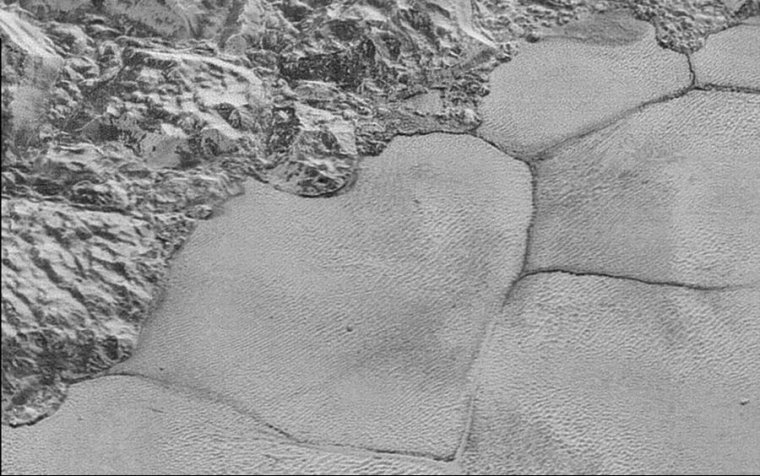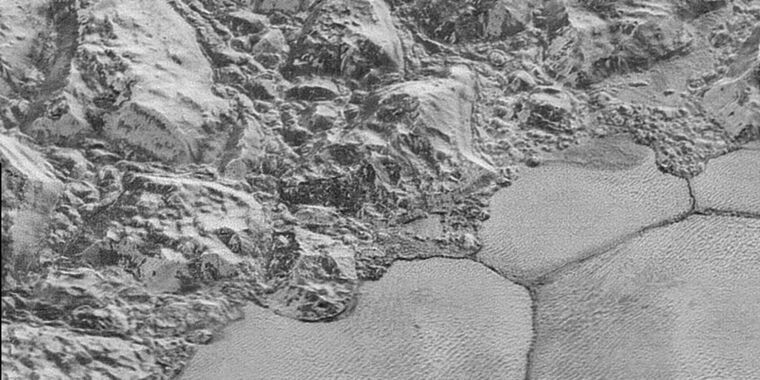
Expectations for active geology on Pluto were pretty low prior to the arrival of the New Horizons probe. But the photos that came back from the dwarf planet revealed a world of mountains, ridges, and… strange lumpy things that don’t have an obvious Earthly analog. One of the more prominent oddities was the plain of Sputnik Planitia, filled with nitrogen ice that was divided into polygonal shapes separated by gullies that were tens of meters deep.
Scientists quickly came up with a partial explanation for these structures: convection, where heat differences cause deeper, warmer nitrogen ices to bubble through the soft material toward the surface. The problem is that the planet has no obvious sources of heat deep inside. Now, however, a group of European researchers is suggesting that the convection could be driven by surface cooling, rather than heat from the planet’s interior. The secret is the sublimation of nitrogen ices directly into vapors.
Lacking heat
Explaining the formations on small, icy bodies like Pluto is difficult because scientists expect that they lack the heat sources that drive plate tectonics, like those on Earth. These icy bodies are small enough that any heat generated by the collisions that built them, and the dwarf planet, dissipated long ago. And they don’t have enough metallic materials for radioisotopes to provide ongoing heat generation. The few exceptions to this, like Europa and Enceladus, are heated by gravitational interactions with the giant planets they orbit, but that’s not an option for Pluto, either.
As such, it’s difficult to come up with a large source of heat that would still be present billions of years after the Solar System’s formation. And that’s a problem for the idea of convection. Here on Earth, the planet’s internal convection is driven by heat escaping from the planet’s core. And that convection in turn drives volcanic activity on the surface. Without that sort of heat, it’s hard to see how convection can drive the features we’re seeing on Pluto.
The insight the European team had was that it’s not absolute heat that’s necessarily needed to drive convection. Rather, it’s the temperature difference that matters (along with the ability of the material involved to deform). So, a way of cooling the surface could be just as effective as a way of heating the interior.
And there was a clear candidate for that. When warmed by the Sun, a small amount of the nitrogen ice will vaporize into a gas in a process called sublimation. And, in the process, the nitrogen molecules that escape take some of the heat of the ice with them, providing a small amount of cooling. It’s not much on a per-atom basis, but Sputnik Planitia is a vast plane of ice, and it has had billions of years to undergo sublimation.
Plus, researchers had already explained other features on Pluto that may be produced by sublimation.
A model sublime
Obviously, we can’t just head out to Pluto to determine whether nitrogen is sublimating off the surface. So instead, the research team built a convection model and used some physically plausible values for the properties of the nitrogen ice and amount of energy available to it. In other cases, they varied parameters across a range to see what values might result in different behavior.
As a first test, they ran their model using sublimation to provide a heat difference to the ice and ran a second version of the model that simply supplied a temperature gradient to the ice. In the latter case, polygons did form, but they looked different from what we see on Pluto. Perhaps most significantly, their high points were near the edges of the polygons, rather than in the center. By contrast, when sublimation was used, things looked very much like Pluto.
By testing out different parameters, the team was able to determine that high-viscosity materials end up stalling out as little fresh material finds its way to the surface. For viscosities that are too low, the model ended up failing to form any areas with significant contrast between them, so no boundary regions are apparent.
Watching the polygons develop indicates that they gradually emerge from random instabilities in the convection and then gradually reorganize into sheet-like downwellings that form the sides of the polygons. Similarly, small-scale plumes gradually condense into the single large upwelling that forms the central region of the plume.
The degree to which this system can operate, however, depends on the details of Pluto’s orbit, details that change over periods of millions of years. So it’s possible that the features formed and decayed multiple times during the dwarf planet’s history.
Nature, 2021. DOI: 10.1038/s41586-021-04095-w (About DOIs).





